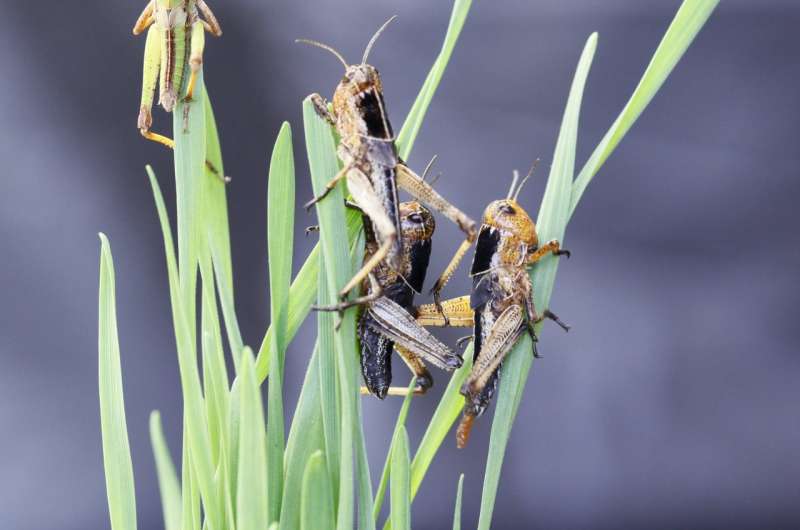How locusts switch colours in different settings

Scientists have discovered how locusts change their body colour to adapt to different environments, according to new research published in eLife.
The findings, first reported on bioRxiv, reveal a novel 'palette effect' mechanism in locusts, whereby a red pigment complex acts as a switch to coordinate between the insects' green and black colouring.
Changes in body colour are important for many animals to adapt and survive in changing environments. In the migratory locust, Locusta migratoria, solitary insects living in low population numbers typically display a green colour, while more sociable (or 'gregarious') locusts living in larger swarms develop a striking pattern of black/brown colouring. But the molecular mechanism underlying these colour changes was largely unknown.
"The green colour of solitary locusts is likely due to a combination of yellow and blue pigments, helping to camouflage the insects among plants as protection from predators," says senior author Le Kang, Ph.D. and Professor at the Institute of Zoology, Chinese Academy of Sciences in Beijing, China. "In our study, we wanted to see whether the brown/black colours of gregarious locusts are caused when pigments are added to their green background following a solitary phase."
To do this, Kang and his team studied gregarious and solitary locusts reared in either crowded conditions or alone. Their genetic analyses first revealed that both types of locusts have different levels of a protein called βCBP, which plays a key role in their colour transition. As the gregarious locusts matured, the researchers found that their black colouring increased in direct relation to their βCBP levels, while protein levels remained unchanged in the solitary locusts.
As βCBP is known to bind to and increase the amount of a red pigment called beta carotene (β-carotene) in the skin, the team next examined this molecular activity in the locusts. They found that the amount of β-carotene in the gregarious locusts was almost a third higher than in the solitary insects, suggesting that the levels of βCBP and associated β-carotene are directly related to the degree of their dark colouration.
To test this further, they next assessed the effect of the βCBP-β-carotene complex on the colour change of locusts from the solitary to gregarious phase. Solitary locusts were fed a diet containing β-carotene and placed in a crowded environment with others. Their βCBP levels increased significantly in this setting, and almost half of them shifted completely to the black/brown colouring, while the rest developed extensive black areas similar to the colouring of gregarious insects. Blocking the protein reversed this effect, changing their colour from black to green.
"This suggests the change in locusts from green to black, caused by the βCBP-β-carotene protein complex, is an adaptive response to population density," Kang explains. "It provides gregarious insects with an alarm colouration that inevitably exposes them to the environment, allowing them to recognise others within the same species, form large populations and warn against predators.
"Overall, we have presented the first evidence that the black/brown colour of these locusts is formed by the red pigment in the protein complex. It will now be interesting to see if a similar mechanism has evolved in other insects that switch colours depending on their surroundings."
More information: Meiling Yang et al, A β-carotene-binding protein carrying a red pigment regulates body-color transition between green and black in locusts, eLife (2019). DOI: 10.7554/eLife.41362
Journal information: eLife
Provided by eLife





















